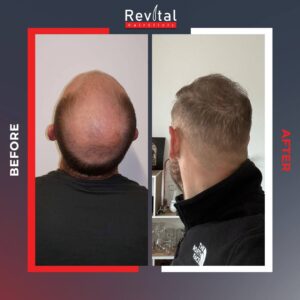What Causes Shock Loss After Hair Transplantation?
Hair transplantation is a highly effective solution for those struggling with hair loss, but it’s not uncommon for patients to experience a phenomenon known as shock loss after the procedure. While this can be alarming, it’s important to understand that shock loss is a normal and temporary part of the healing process. It doesn’t indicate a problem with the hair transplant itself, but rather a reaction to the surgical procedure.
In this article, we’ll explore the causes of shock loss after hair transplantation, why it happens, how long it lasts, and what you can do to manage it.
What is Shock Loss After Hair Transplantation?
Shock loss refers to the temporary shedding of hair that occurs after a hair transplant. This shedding may affect both the transplanted hair and the natural hair in the recipient area. While this can be unsettling for patients, shock loss is a common part of the hair restoration process.
It’s important to note that shock loss is usually temporary, and the hair will start to regrow after a few months. The newly transplanted follicles are simply adjusting to their new environment, while existing hair may shed due to the stress of the procedure.
What Causes Shock Loss After Hair Transplantation?
Several factors contribute to shock loss after a hair transplant. Let’s take a closer look at the most common causes:
- Trauma to the Scalp
One of the primary reasons for shock loss is the trauma caused to the scalp during the hair transplant procedure. Whether it’s the extraction of hair follicles from the donor area or the implantation of those follicles into the recipient area, these processes cause physical stress to the scalp and hair follicles.
This trauma can trigger the hair follicles in both the recipient and donor areas to enter the telogen phase (resting phase) of the hair growth cycle, which leads to hair shedding. While it may seem alarming, this shedding is temporary, and the follicles will eventually enter the anagen (growth) phase again.
- Disruption of Blood Supply
For hair follicles to grow, they require a consistent supply of nutrients and oxygen, which are delivered through the blood vessels in the scalp. During a hair transplant, the recipient area’s blood supply may be temporarily disrupted.
This reduced blood flow can affect both transplanted and existing hair follicles, causing them to shed. Once the blood flow stabilizes and the follicles are able to access the nutrients they need, hair regrowth will begin.
- Stress on the Hair Follicles
When hair follicles are moved from the donor area to the recipient area, they undergo a process of adjustment. The follicles, which were previously in a stable environment, are now in a different location, with different blood supply and nutrient levels. This adjustment can cause stress on the follicles, leading to temporary shedding.
The hair follicles will eventually adapt to their new environment, and new hair growth will begin within a few months.
- Natural Hair Growth Cycle
Hair follicles go through a natural growth cycle that includes several phases: anagen (growth), catagen (transition), and telogen (resting). After a hair transplant, existing hair in the recipient area may enter the telogen phase earlier than usual, which causes it to shed.
While this shedding may be concerning, it is simply part of the natural cycle, and the hair will eventually begin to regrow as the follicles transition back into the anagen (growth) phase.
- Shock to the Existing Hair (Telogen Effluvium)
Another contributing factor to shock loss is telogen effluvium, a condition in which hair falls out prematurely due to a shock or stressor to the body, such as surgery or trauma. The trauma caused by the hair transplant, as well as the stress that comes with the procedure and the recovery period, can trigger telogen effluvium, leading to the shedding of both transplanted and existing hair.
⏳ When Does Shock Loss Occur After a Hair Transplant?
Shock loss usually occurs within the first 2 to 4 weeks after the transplant. Here’s a general timeline for what you can expect:
- Week 1-2: Immediately after the transplant, you may notice some shedding of both the transplanted hair and the natural hair in the recipient area. This is the beginning of the shock loss phase.
- Week 3-4: Shock loss continues during this time as the hair follicles in the recipient area begin to adjust. You may experience an increase in hair shedding, but rest assured this is normal.
- Month 2-3: At this point, the shedding may peak, but it should gradually slow down. The transplanted follicles are preparing to enter the resting phase, which can result in additional shedding.
- Month 4-6: After the shock loss phase ends, new hair should begin to grow from the transplanted follicles. The hair growth may initially be fine and thin, but it will gradually thicken over time.
How Long Does Shock Loss Last?
Shock loss typically lasts between 2 and 4 months, although the duration can vary depending on the individual. The shedding usually slows down as the scalp heals and the follicles transition back into the growth phase. After this phase, the transplanted hair follicles will begin to regrow, and the patient will begin to see results.
While shock loss can be concerning, it’s important to remember that it is temporary and that hair regrowth usually starts within 3-6 months of the transplant.
⚕️ What Can You Do to Minimize Shock Loss?
While shock loss is a normal part of the recovery process, there are several things you can do to manage it and support the regrowth of your hair:
- Follow Post-Operative Care Instructions:
- After your transplant, it’s important to follow your surgeon’s post-operative instructions carefully. This may include how to care for your scalp, what products to use, and when to resume normal activities.
- Avoid activities that can cause trauma to the scalp, such as scratching or vigorous washing of your hair.
- Be Patient:
- Remember that shock loss is a temporary phase. The transplanted follicles are simply adjusting to their new location, and once they settle, new hair growth will begin. It’s crucial to be patient and give your hair time to regrow.
- Consult with Your Surgeon:
- If you’re concerned about the extent of shock loss or if you’re unsure whether the shedding is normal, consult with your surgeon. They can assess the situation and provide reassurance or recommend treatments such as PRP therapy (Platelet-Rich Plasma) to enhance the healing process and support hair growth.
- Maintain a Healthy Diet:
- A balanced diet with the right nutrients, including vitamins and minerals that support hair health (such as vitamin A, C, E, zinc, and biotin), can help promote faster regrowth of your hair.
In Conclusion
Shock loss is a common and temporary occurrence following a hair transplant. It is caused by factors like trauma to the scalp, disruption of blood supply, and the natural hair growth cycle. While it can be concerning, it’s important to understand that shock loss is a normal part of the healing process, and your hair will begin to regrow within a few months.
If you experience shock loss after your transplant, don’t panic. Be patient, follow your surgeon’s post-operative care instructions, and consult with them if you have concerns. In the end, the transplanted hair will settle into its new location, and you will enjoy long-lasting, natural-looking results.
If you’re considering a hair transplant or have any questions about shock loss, Revital Hair Clinic is here to help. Our experienced team of specialists can guide you through every step of the process, ensuring a successful and satisfying hair restoration journey.
Revital Hair Clinic © 2024












Leave a Reply